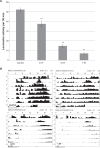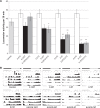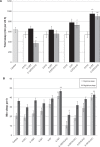Effect of taurine and caffeine on sleep-wake activity in Drosophila melanogaster
- PMID: 23616711
- PMCID: PMC3630960
- DOI: 10.2147/NSS.S13034
Effect of taurine and caffeine on sleep-wake activity in Drosophila melanogaster
Abstract
Caffeine and taurine are two major neuromodulators present in large quantities in many popular energy drinks. We investigated their effects on sleep-wake control in constant darkness using the fruit fly Drosophila as a model system. It has been shown that caffeine, as the most widely used psychostimulant, can boost arousal through the dopamine pathway in the mushroom bodies of flies. Taurine is a GABA receptor agonist, which is inhibitory to neuronal firing. We show here that flies receiving a low dose of caffeine (0.01%) increase locomotor activity by 25%, and decrease total sleep by 15%. Treatment with taurine at 0.1% to 1.5% reduces locomotor activity by 28% to 86%, and shifts it from diurnal to nocturnal. At 0.75%, taurine also increases total sleep by 50%. Our results show that taurine increases sleep, while caffeine, as previously reported, attenuates sleep. Flies treated with both caffeine and taurine exhibit two differential effects which depend upon the ratio of taurine to caffeine. A high taurine:caffeine ratio promotes sleep, while a low ratio of taurine:caffeine inhibits sleep to a greater extent than the equivalent amount of caffeine alone. This intriguing enhancement of caffeine action by low doses of taurine may account for the presence of both compounds in energy-promoting drinks such as Red Bull® and Monster®.
Keywords: GABA (γ-aminobutyric acid); caffeine (trimethylxanthine); energy drinks; locomotor activity; sleep; taurine (2-aminoethanesulfonic acid).
Figures





Similar articles
-
Nelumbo nucifera Seed Extract Promotes Sleep in Drosophila melanogaster.Biol Pharm Bull. 2018;41(3):399-408. doi: 10.1248/bpb.b17-00763. Biol Pharm Bull. 2018. PMID: 29491217
-
Behavioral Changes and Survival in Drosophila melanogaster: Effects of Ascorbic Acid, Taurine, and Caffeine.Biol Pharm Bull. 2017;40(11):1873-1882. doi: 10.1248/bpb.b17-00321. Biol Pharm Bull. 2017. PMID: 29093334
-
Effect of explosion-puffed coffee on locomotor activity and behavioral patterns in Drosophila melanogaster.Food Res Int. 2017 Oct;100(Pt 2):252-260. doi: 10.1016/j.foodres.2017.08.051. Epub 2017 Aug 24. Food Res Int. 2017. PMID: 28888448
-
Safety issues associated with commercially available energy drinks.J Am Pharm Assoc (2003). 2008 May-Jun;48(3):e55-63; quiz e64-7. doi: 10.1331/JAPhA.2008.07055. J Am Pharm Assoc (2003). 2008. PMID: 18595815 Review.
-
Alcohol mixed with energy drinks: what about taurine?Psychopharmacology (Berl). 2021 Jan;238(1):1-8. doi: 10.1007/s00213-020-05705-7. Epub 2020 Nov 11. Psychopharmacology (Berl). 2021. PMID: 33175215 Review.
Cited by
-
Microengineered devices enable long-term imaging of the ventral nerve cord in behaving adult Drosophila.Nat Commun. 2022 Aug 25;13(1):5006. doi: 10.1038/s41467-022-32571-y. Nat Commun. 2022. PMID: 36008386 Free PMC article.
-
Characterizing Genetic-Predisposed Proteins Involving Insomnia by Integrating Genome-Wide Association Study Summary Statistics.Mol Neurobiol. 2025 May;62(5):6576-6586. doi: 10.1007/s12035-025-04695-x. Epub 2025 Jan 18. Mol Neurobiol. 2025. PMID: 39827250 Free PMC article.
-
Fly into tranquility: GABA's role in Drosophila sleep.Curr Opin Insect Sci. 2024 Aug;64:101219. doi: 10.1016/j.cois.2024.101219. Epub 2024 Jun 5. Curr Opin Insect Sci. 2024. PMID: 38848811 Free PMC article. Review.
-
Dietary Zinc Acts as a Sleep Modulator.Int J Mol Sci. 2017 Nov 5;18(11):2334. doi: 10.3390/ijms18112334. Int J Mol Sci. 2017. PMID: 29113075 Free PMC article. Review.
-
Nutrition Influences Caffeine-Mediated Sleep Loss in Drosophila.Sleep. 2017 Nov 1;40(11):zsx146. doi: 10.1093/sleep/zsx146. Sleep. 2017. PMID: 29029291 Free PMC article.
References
-
- Food and Drug Administration Substances generally recognized as safe. Code of Federal Regulations. 2003. Title 21 volume 2, Sec 182.1180. Accessed at: http://www.cfsan.fda.gov/~lrd/fcf182.html.
-
- Roehrs T, Roth T. Caffeine: sleep and daytime sleepiness. Sleep Med Rev. 2008;12:153–162. - PubMed
-
- Huxtable RJ. Physiological actions of taurine. Physiol Rev. 1992;72(1):101–163. - PubMed
LinkOut - more resources
Full Text Sources
Molecular Biology Databases

